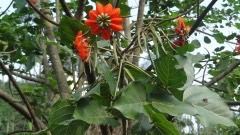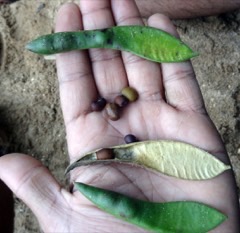 |
|
wikimedia.org Siddarth Machado |
 |
| wikimedia.org Siddarth Machado |
Translate this page:
Summary
Physical Characteristics

 Erythrina subumbrans is a deciduous Tree growing to 20 m (65ft) by 20 m (65ft) at a fast rate.
Erythrina subumbrans is a deciduous Tree growing to 20 m (65ft) by 20 m (65ft) at a fast rate.
See above for USDA hardiness. It is hardy to UK zone 10. The flowers are pollinated by Birds.
It can fix Nitrogen.
Suitable for: light (sandy), medium (loamy) and heavy (clay) soils and prefers well-drained soil. Suitable pH: mildly acid, neutral and basic (mildly alkaline) soils. It cannot grow in the shade. It prefers dry or moist soil and can tolerate drought.
UK Hardiness Map
US Hardiness Map
Synonyms
Corallodendron lithospermum (Blume ex Miq.) Kuntze Erythrina holoserica Kurz Erythrina lithosperma Miq. Erythrina secundiflora Hassk. Erythrina sumatrana Miq. Hypaphorus subumbrans Hassk.
Plant Habitats
Edible Uses
Edible Parts: Leaves Stem
Edible Uses:
Very young leaves are steamed and eaten in salads[303 , 701 ].
References More on Edible Uses
Medicinal Uses
Plants For A Future can not take any responsibility for any adverse effects from the use of plants. Always seek advice from a professional before using a plant medicinally.
A decoction of the bark is taken to the treat spleen afflictions[303 ]. A decoction of the leaves is used as a treatment for coughs[303 ]. The pounded young leaves are used as a poultice for women soon after giving birth and as a treatment for headache[303 ]. The juice of the leaves is used as an eye-wash[303 ].
References More on Medicinal Uses
The Bookshop: Edible Plant Books
Our Latest books on Perennial Plants For Food Forests and Permaculture Gardens in paperback or digital formats.

Edible Tropical Plants
Food Forest Plants for Hotter Conditions: 250+ Plants For Tropical Food Forests & Permaculture Gardens.
More

Edible Temperate Plants
Plants for Your Food Forest: 500 Plants for Temperate Food Forests & Permaculture Gardens.
More

More Books
PFAF have eight books available in paperback and digital formats. Browse the shop for more information.
Shop Now
Other Uses
Fodder
Agroforestry Uses: Grown as a shade tree in cocoa, coffee and tea plantations. It is also used as a shelter crop for taro (Colocasia esculenta) and as live support for yams (Dioscorea spp.), betel nut (Piper betle), pepper (Piper nigrum) and vanilla (Vanilla planivolia) vines[303 ]. Loppings of the plant provide a quickly decomposing green manure, containing per 100 g dry matter: N 1.5-3 g, P 0.2-0.35 g, K 1-2 g[310 ]. The tree is planted as a pioneer species in northern Thailand in reforestation projects to restore native woodland - it is planted in degraded woodland and open areas in a mix with various other species that all have the ability to grow fast; produce dense, weed-suppressing crowns; and attract seed-dispersing wildlife, particularly birds and bats[998 ]. Other Uses The wood is soft, light and coarse-grained, the texture coarse and uneven[310 ]. The sapwood is not differentiated from the heartwood, which is light straw-coloured[310 ]. It is utilized in canoe and raft building[303 , 310 ].
Special Uses
Carbon Farming
References More on Other Uses
Cultivation details
Agroforestry Services: Crop shade Agroforestry Services: Living fence Agroforestry Services: Living trellis Agroforestry Services: Nitrogen Fodder: Bank Management: Coppice Management: Standard Regional Crop
A plant of low to medium elevations in the tropics, where it is usually found at elevations below 1,500 metres[303 ]. It is found in areas where the mean annual rainfall is in the range 500 - 2,000mm and there is a maximum of 4 months with less than 100mm rainfall[303 ]. The mean annual temperature is above 22°c[303 ]. The trees are fairly tolerant of wind, unless branches have been damaged by borers[303 ]. Often grown as an ornamental or to provide shade in plantations, the tree has occasionally escaped from cultivation and become naturalized. It is classified as invasive in some Pacific islands[305 ]. Thornless forms generally produce fewer flowers and fruit than wild forms which have spines[310 ]. The cultivated thornless forms may reach an age of 40 - 50 years, but often die earlier because of diseases and pests[303 ]. Pruning and pollarding are very well tolerated[303 ]. Where the tree is pruned, it is sometimes used as a medium level shade tree, interplanted with taller shade trees like Paraserianthes falcataria or Grevillea robusta[303 ]. Elsewhere, it is not pruned and is used for high shade, interplanted with Leucaena leucocephala to provide the low shade[303 ]. In Western Samoa, yam vines planted in a circle around a tree are allowed to cover the canopy and suppress its growth[303 ]. The flowers contain large quantities of nectar and are a major source of food for birds during the dry season[310 ]. The various species of Erythrina can all, as far as is known, be intercrossed to produce fertile hybrids[310 ]. This species has a symbiotic relationship with certain soil bacteria, these bacteria form nodules on the roots and fix atmospheric nitrogen. Some of this nitrogen is utilized by the growing plant but some can also be used by other plants growing nearby[755 ].
Carbon Farming
-
Agroforestry Services: Crop shade
Plants providing crop shade especially trees.
-
Agroforestry Services: Living fence
Simply managed rows of shrubs and trees.
-
Agroforestry Services: Living trellis
Plants to physically support other crops.
-
Agroforestry Services: Nitrogen
Plants that contribute to nitrogen fixation include the legume family – Fabaceae.
-
Fodder: Bank
Fodder banks are plantings of high-quality fodder species. Their goal is to maintain healthy productive animals. They can be utilized all year, but are designed to bridge the forage scarcity of annual dry seasons. Fodder bank plants are usually trees or shrubs, and often legumes. The relatively deep roots of these woody perennials allow them to reach soil nutrients and moisture not available to grasses and herbaceous plants.
-
Management: Coppice
Cut to the ground repeatedly - resprouting vigorously. Non-destructive management systems maintaining the soil organic carbon.
-
Management: Standard
Plants grow to their standard height. Harvest fruit, seeds, or other products. Non-Destructive management systems.
-
Regional Crop
These crops have been domesticated and cultivated regionally but have not been adopted elsewhere and are typically not traded globally, Examples in this broad category include perennial cottons and many nuts and staple fruits.
References Carbon Farming Information and Carbon Sequestration Information
Temperature Converter
Type a value in the Celsius field to convert the value to Fahrenheit:
Fahrenheit:
The PFAF Bookshop
Plants For A Future have a number of books available in paperback and digital form. Book titles include Edible Plants, Edible Perennials, Edible Trees,Edible Shrubs, Woodland Gardening, and Temperate Food Forest Plants. Our new book is Food Forest Plants For Hotter Conditions (Tropical and Sub-Tropical).
Shop Now
Plant Propagation
Fresh seeds, and those harvested within 3 - 6 months of maturity, can be sown without any special treatment. Germination rates are generally high and are often 100%. Seeds over 6 months old may take between 12 - 18 months to germinate due to their hard seed coat which becomes tougher with age. Soaking them in hot water, or abrading their seedcoat, can reduce this time considerably. They may be added to water which has just fallen below boiling point and left in the water as it cools for a minimum of one hour, but up to 12 hours for seed 3 years or more old, and then sown in the usual way. Alternatively, file the seeds with a slender triangular file. A groove can be made through the sides of the seed coat with care so as to avoid damaging the cotyledons or embryo, which usually results in the death of the seeds from fungal attack or in malformed and weakened seedlings[564 ]. Seeds of most species produce strong seedlings from healthy seeds in almost any well-drained soil, with a minimum of trouble from damping-off disease[564 ]. The plant can be propagated by seed, but seeds from thornless trees generally produce trees with thorns[303 ]. Large cuttings, even if they are 25 cm in diameter, usually root easily[303 ].
Other Names
If available other names are mentioned here
Chengkering, Coral tree, Dadap lenga, Dadap lesang, Dadap limit, Dadap lisa, Dadap minyak, Dadap rangrang, Dadap ri, Dadap srep, Dedap batik, Dedap, Dhadhak, Gatae palagi, Pohon dadap rangrang, Tawng lang, Tawng pa, Vong hot-da, Ye-kathit
Native Range
TROPICAL ASIA: India, Sri Lanka, Laos, Myanmar, Thailand, Vietnam, Indonesia, Malaysia, Philippines, East Timor
Weed Potential
Right plant wrong place. We are currently updating this section.
Please note that a plant may be invasive in one area but may not in your area so it's worth checking.
It is classified as invasive in some Pacific islands[305 ].
Conservation Status
IUCN Red List of Threatened Plants Status : This taxon has not yet been assessed

Growth: S = slow M = medium F = fast. Soil: L = light (sandy) M = medium H = heavy (clay). pH: A = acid N = neutral B = basic (alkaline). Shade: F = full shade S = semi-shade N = no shade. Moisture: D = dry M = Moist We = wet Wa = water.
Now available:
Food Forest Plants for Mediterranean Conditions
350+ Perennial Plants For Mediterranean and Drier Food Forests and Permaculture Gardens.
[Paperback and eBook]
This is the third in Plants For A Future's series of plant guides for food forests tailored to
specific climate zones. Following volumes on temperate and tropical ecosystems, this book focuses
on species suited to Mediterranean conditions—regions with hot, dry summers and cool, wet winters,
often facing the added challenge of climate change.
Read More
Expert comment
Author
(Hassk.) Merr.
Botanical References
Links / References
For a list of references used on this page please go here
A special thanks to Ken Fern for some of the information used on this page.
Readers comment
| Add a comment |
|
If you have important information about this plant that may help other users please add a comment or link below. Only comments or links that are felt to be directly relevant to a plant will be included. If you think a comment/link or information contained on this page is inaccurate or misleading we would welcome your feedback at [email protected]. If you have questions about a plant please use the Forum on this website as we do not have the resources to answer questions ourselves.
* Please note: the comments by website users are not necessarily those held by PFAF and may give misleading or inaccurate information.
To leave a comment please Register or login here All comments need to be approved so will not appear immediately.
|
Subject : Erythrina subumbrans
|
|
|
|